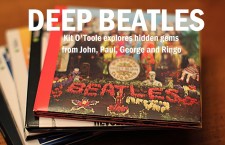Stories of the Beatles’ 1964 North American tour have gone down in legend — the screaming girls, the mob scenes, transporting the group from airport to hotel, and jellybeans hurled onstage because American audiences misunderstood interviews where the band professed to love “jelly babies.” While fans may be well acquainted with those tales, they will never fully comprehend what it was like to be in the center of the Beatlemania hurricane.
Journalist Ivor Davis paints a vivid picture for readers in The Beatles and Me on Tour, an account of his month traveling with the band as an embedded correspondent. At once humorous and terrifying, Davis’ recollections lend a new and thoroughly detailed perspective on how the Beatles coped with those early days of fame.
Davis found himself in the middle of the madness due to a special assignment. As the West Coast correspondent for London Daily Express, he was ordered to travel with the Beatles during their hectic 1964 trek, earning their trust and submitting reports from the road. In addition, Davis assumed another role: George Harrison’s ghostwriter.
Hired to write a weekly column for the newspaper, Harrison had little time nor interest in the task. In turn, Davis initially found it difficult to work with the reluctant Beatle. At first Harrison refused to talk to him, forcing Davis to make up material, trying to capture Harrison’s voice through prose. Eventually Harrison confronted the journalist, proclaiming “I’m told my column is boring — a load of old shite.” Davis retorted: “Well, it might help if you bothered to tell me what exactly you want to say,”
From that moment, Davis states, the ice began to melt, with the two of them having heartfelt conversations about family and the price of fame. The reporter also grew fond of John Lennon; the two would play Monopoly together — with Lennon often cheating. Davis candidly reveals the sex, drugs, and rock and roll-filled life on the road, with the group often popping pills to keep up with the tour’s hectic pace. (Davis also disputes the date of one infamous incident: the night Bob Dylan introduced the Beatles to pot.) Davis reports this behavior fairly objectively, not passing judgment.
Indeed, Davis illustrates how Beatlemania was equal parts scary and exciting. Today, footage of fainting teenage girls may amuse, but the writer reveals how many fans emerged from the shows with wounds. In various cities, police were often unprepared for the frantic crowds, their efforts to construct “safety zones” using fences mostly useless.
Davis discusses looking on with horror as police horses trampled two girls at a New Orleans show; the next day, Davis submitted a report to the London Daily Express stating “more than twenty youngsters were treated for broken noses, legs, arms, and cuts and bruises.” Occasionally, fans would break through security, run on the stage, and practically tackle the Beatles to the ground. Davis marvels how they would continue playing without missing a beat.
In addition to recounting such wild scenes, Davis profiles two significant members of the Beatles’ team: Brian Epstein and Derek Taylor Both benefit from Davis’ rich detail, which draws fuller pictures of complex characters. Davis’ portrayal of Epstein as a tortured, moody man struggling with homosexuality and his Jewish identity is at once enlightening and heartbreaking.
Fans may not agree with Davis’ assessment of the Beatles’ musical abilities. At one point, he states that 1964 audiences “never really got their money’s worth” due to the short sets and “fairly simple, early ditties about holding your hand or dancing with you. The hits that resonated through America in 1964 were not the ones that were to give the later Beatles their remarkable longevity.” Davis’ stories about life on the road prove more authentic, and effectively draw from his own experience as a journalist — not a music critic.
Despite this shortcoming, The Beatles and Me on Tour vividly reveals the inner workings of the Beatles’ hugely successful 1964 North American jaunt. He portrays the group as human, coping with the madness surrounding them. Few have experienced anything like it, and Davis’ prose lets readers vicariously experience the tornado that was Beatlemania.
- How John Lennon Came Roaring Back on the Beatles’ White Album - November 22, 2023
- Five ‘With the Beatles’ Deep Cuts That Illustrate Their Lasting Debt to R&B - November 20, 2023
- Five Must-Hear Deep Cuts from the Beatles’ ‘Past Masters’ - March 7, 2023



